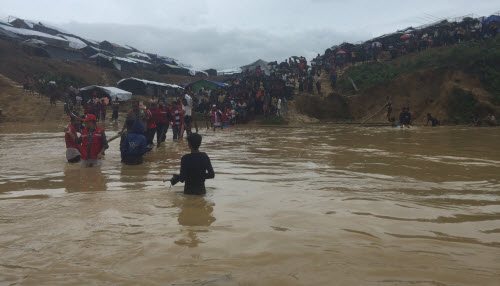Bangladesh Population Movement
Topics: Myanmar Refugee Crisis,
Diana Coulter | September 28, 2017

Double the Impact of Your Donation
The Government of Canada has announced that for every donation made between August 25 to November 28 to Canadian charities, including the Canadian Red Cross, in support of this crisis will be matched in their Myanmar Crisis Relief Fund. Every gift made during this time will have double the impact to help vulnerable people during this humanitarian crisis.
As far as the eye can see across steep, muddy hills nearly stripped of trees, people huddle under rickety shelters of bamboo and black tarps near the Bangladesh border with Myanmar.
“What you first notice is just the sheer size and scale of the settlements that keep expanding every day,” as people flee violence in Myanmar’s Rakhine state, says Lauralee Morris, a Canadian doctor who arrived in Bangladesh roughly two weeks ago to join an assessment team for the International Federation of Red Cross (IFRC).
As a member of FACT (Field Assessment Coordination Team), Morris is helping assess the needs of people displaced and planning a scaled-up response, as a result of the ongoing population movement. Working with the Bangladesh Red Crescent Society (BDRCS), the IFRC FACT team also helps coordinate the RC Movement relief operation with other humanitarian agencies.
“Already we can see that basically, these people need almost everything. They’re extremely vulnerable,” says Morris, who is assessing health needs for FACT. Other team members from Finland, Australia, Austria and elsewhere are examining shelter, water and other needs.
In the last few weeks, an estimated 436,000 people have crossed the Myanmar border into Bangladesh. Sixty-three percent are women and girls. This new influx is putting more pressure on basic resources and services, such as food, healthcare, shelter, education, water and sanitation already stretched thin by past movements that totalled about 500,000 people.
Morris says the scale of the emergency was put into perspective when she realized her hometown of Brampton, Ontario has about half a million people. “When you think of all the basic services needed by a large community like Brampton, it’s very hard to see and absorb how great the need is here.”
The IFRC and Bangladesh Red Crescent are providing water, food, shelter and other relief items, as well as support for medical and mental health needs. But more is needed for new arrivals. International organizations have identified emergency shelter, access to clean water, sanitation and hygiene, medical care and food as the most urgent needs.
However, this is not the beginning of the Movement response in Bangladesh. The Bangladesh Red Crescent has been providing aid and addressing the needs of people fleeing violence in northern areas of the Rakhine state since October 2016. These same people were also affected by Cyclone Mora earlier this year, which only adds to their vulnerability.
With funding from the Canadian federal government, the Canadian Red Cross has already contributed to the IFRC’s Population Movement Appeal, deployed Morris to help with needs assessments, and stands ready to offer further support from its roster of trained aid workers and pre-positioned supplies.
So far, Morris says, the assessment team has been setting out on foot because only one road winds through the steep, muddy valleys covered in makeshift shelters. Older established camps have now merged with new spontaneous settlements into sprawling “super camps.”
The days are long and challenging, she says, as the team climbs slick slopes, or wades across murky canals. One day, they walked through water up to their shins, only to return a few hours later to find a strong current rising to their waists. “I only had to cross that canal once and displaced people are likely doing it every day, just to get food, water and other basic things,” says Morris.
Difficulties are compounded by the fact that most people are already “very distressed and traumatized,” by violence in Rakhine state. There are also a lot of children arriving alone, “so protection issues are a real concern,” she adds.
The Bangladesh Red Crescent Society is leading efforts on protection and reunification of unaccompanied and separated children with their families.
"The number of displaced people here in Bangladesh trying to exist in extremely difficult terrain is unbelievable,” says Morris. “But we're here to help."
Canadians wishing to support emergencies, like the Bangladesh Population Movement, can donate to our International Disaster Relief Fund. Donations will be used to support the ongoing efforts of the Canadian Red Cross and our ability to respond within hours of a disaster, anywhere in the world.
Regions
NationalAlberta
British Columbia
Manitoba
New Brunswick
Newfoundland and Labrador
Northwest Territories
Nova Scotia
Ontario
Prince Edward Island
Quebec
Saskatchewan
Nunavut
Yukon
Worldwide
Africa
Americas
Asia
Middle East and North Africa
Europe
Topics
Community HealthEmergencies and Disasters in Canada
Emergencies and Disasters Worldwide
Finding Family
First Aid and CPR
International Humanitarian Law
Migrant and Refugee Services
Our Impact on the Ground
Philanthropy News
Violence, Bullying and Abuse Prevention
Volunteer
Water Safety
Youth
Indigenous Communities
Maternal Newborn and Child Health
Refugee Crisis
Refugee Arrival
